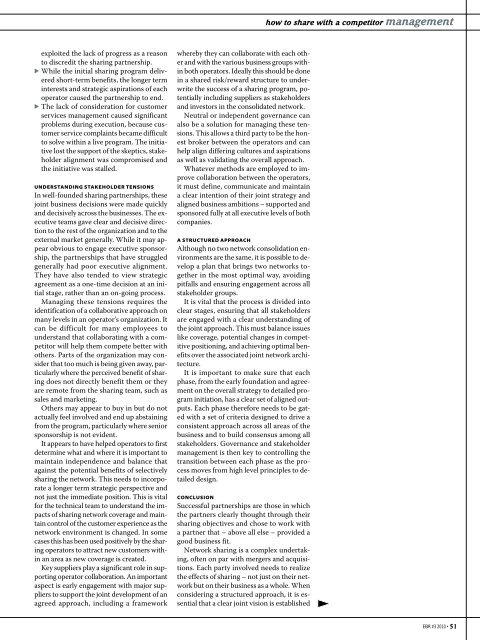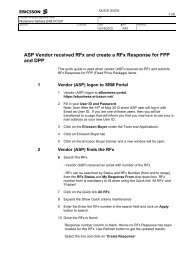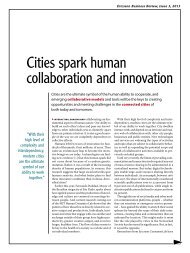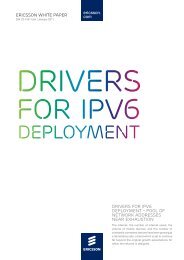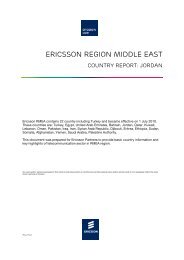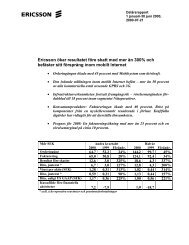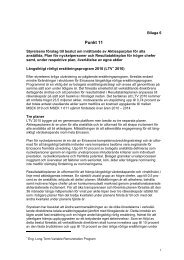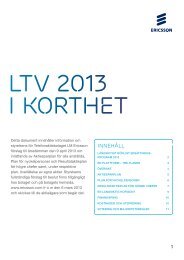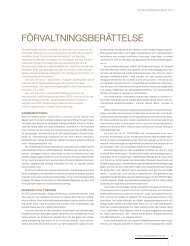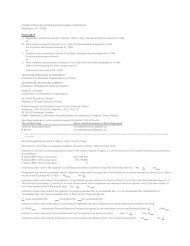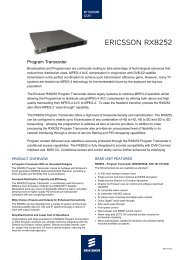Telenor's - Ericsson
Telenor's - Ericsson
Telenor's - Ericsson
- TAGS
- ericsson
- www.ericsson.com
You also want an ePaper? Increase the reach of your titles
YUMPU automatically turns print PDFs into web optimized ePapers that Google loves.
exploited the lack of progress as a reason<br />
to discredit the sharing partnership.<br />
▶ While the initial sharing program delivered<br />
short-term benefits, the longer term<br />
interests and strategic aspirations of each<br />
operator caused the partnership to end.<br />
▶ The lack of consideration for customer<br />
services management caused significant<br />
problems during execution, because customer<br />
service complaints became difficult<br />
to solve within a live program. The initiative<br />
lost the support of the skeptics, stakeholder<br />
alignment was compromised and<br />
the initiative was stalled.<br />
UNDERSTANDING STAKEHOLDER TENSIONS<br />
In well-founded sharing partnerships, these<br />
joint business decisions were made quickly<br />
and decisively across the businesses. The executive<br />
teams gave clear and decisive direction<br />
to the rest of the organization and to the<br />
external market generally. While it may appear<br />
obvious to engage executive sponsorship,<br />
the partnerships that have struggled<br />
generally had poor executive alignment.<br />
They have also tended to view strategic<br />
agreement as a one-time decision at an initial<br />
stage, rather than an on-going process.<br />
Managing these tensions requires the<br />
identification of a collaborative approach on<br />
many levels in an operator’s organization. It<br />
can be difficult for many employees to<br />
understand that collaborating with a competitor<br />
will help them compete better with<br />
others. Parts of the organization may consider<br />
that too much is being given away, particularly<br />
where the perceived benefit of sharing<br />
does not directly benefit them or they<br />
are remote from the sharing team, such as<br />
sales and marketing.<br />
Others may appear to buy in but do not<br />
actually feel involved and end up abstaining<br />
from the program, particularly where senior<br />
sponsorship is not evident.<br />
It appears to have helped operators to first<br />
determine what and where it is important to<br />
maintain independence and balance that<br />
against the potential benefits of selectively<br />
sharing the network. This needs to incorporate<br />
a longer term strategic perspective and<br />
not just the immediate position. This is vital<br />
for the technical team to understand the impacts<br />
of sharing network coverage and maintain<br />
control of the customer experience as the<br />
network environment is changed. In some<br />
cases this has been used positively by the sharing<br />
operators to attract new customers within<br />
an area as new coverage is created.<br />
Key suppliers play a significant role in supporting<br />
operator collaboration. An important<br />
aspect is early engagement with major suppliers<br />
to support the joint development of an<br />
agreed approach, including a framework<br />
whereby they can collaborate with each other<br />
and with the various business groups within<br />
both operators. Ideally this should be done<br />
in a shared risk/reward structure to underwrite<br />
the success of a sharing program, potentially<br />
including suppliers as stakeholders<br />
and investors in the consolidated network.<br />
Neutral or independent governance can<br />
also be a solution for managing these tensions.<br />
This allows a third party to be the honest<br />
broker between the operators and can<br />
help align differing cultures and aspirations<br />
as well as validating the overall approach.<br />
Whatever methods are employed to improve<br />
collaboration between the operators,<br />
it must define, communicate and maintain<br />
a clear intention of their joint strategy and<br />
aligned business ambitions – supported and<br />
sponsored fully at all executive levels of both<br />
companies.<br />
A STRUCTURED APPROACH<br />
Although no two network consolidation environments<br />
are the same, it is possible to develop<br />
a plan that brings two networks together<br />
in the most optimal way, avoiding<br />
pitfalls and ensuring engagement across all<br />
stakeholder groups.<br />
It is vital that the process is divided into<br />
clear stages, ensuring that all stakeholders<br />
are engaged with a clear understanding of<br />
the joint approach. This must balance issues<br />
like coverage, potential changes in competitive<br />
positioning, and achieving optimal benefits<br />
over the associated joint network architecture.<br />
It is important to make sure that each<br />
phase, from the early foundation and agreement<br />
on the overall strategy to detailed program<br />
initiation, has a clear set of aligned outputs.<br />
Each phase therefore needs to be gated<br />
with a set of criteria designed to drive a<br />
consistent approach across all areas of the<br />
business and to build consensus among all<br />
stakeholders. Governance and stakeholder<br />
management is then key to controlling the<br />
transition between each phase as the process<br />
moves from high level principles to detailed<br />
design.<br />
CONCLUSION<br />
Successful partnerships are those in which<br />
the partners clearly thought through their<br />
sharing objectives and chose to work with<br />
a partner that – above all else – provided a<br />
good business fit.<br />
Network sharing is a complex undertaking,<br />
often on par with mergers and acquisitions.<br />
Each party involved needs to realize<br />
the effects of sharing – not just on their network<br />
but on their business as a whole. When<br />
considering a structured approach, it is essential<br />
that a clear joint vision is established<br />
how to share with a competitor management<br />
EBR #3 2010 51


